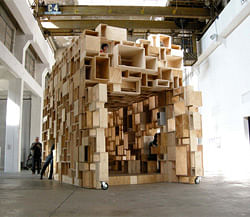Future of community culture in plywood grid boxes
A multi-purpose vertical box as the culture space of the future? When built space in crammed urban metropolises shrink to matchbox settlements, popular culture and intellectual activity will have to accommodate themselves in 3x6 metre community hubs.

In states like Delhi, cultural interface will then take place in "Cyber Mohalla Hubs"- a futuristic concept of a community centre that blurs the boundaries between storage, display, activity, dialogue, inside and outside with a multi-purpose design.
A model of a Cyber Mohalla Hub designed by India-based German avant garde artists Nikolaus Hirsch and Michele Muller at the Devi Art Foundation - a private archive owned by collectors Lekha and Anupam Poddar - in the capital is trying to open a broad-based cultural dialogue around utility and space in a nine-month new media arts project "Sarai Reader 09" that started Aug 18 and will continue till April 16 next year.
The three-storeyed hub is built from a single block of woodply-board. It stands like a ragged edifice in the courtyard of the archive.
The specification of 3x6 metres - around the vertical and horizontal length - is designed to fit the Delhi Rehabilitation Colony plots at Ghevra on the northwest edge of the capital, where the artists' ensemble has built one as a pilot.
Ghevra was developed as one of the biggest resettlement areas by the Delhi Urban Shelter Improvement Board to resettle shanty dwellers from the core city area nearly six years ago.
The ensemble of artists wanted to explore how cultural and intellectual activity could evolve in a resettlement sprawl in minimal space and on austerity of scale - yet ensuring maximum engagement.
The "mohalla" with its grid of storage, writing, display and performance space in mini-cubicles can work with 70 performers across an arc of genres like animation, photography, story-telling, performance, radio, broadsheets, wall writing, magazines and blogging.
The participants can park themselves on small writing seats carved into the inner facade of the building amid the file cabinets and book shelves.
The exhibition has been curated by a Delhi-based artists' collective, Raqs Media Collective.
Hirsch and Muller has collaborated with the Cybermohalla Ensemble of the Society for Alternatives in Education (SARAI) - an umbrella of foreign and Indian artists working in Delhi - to search alternative infrastuctures for creative life in the busy conversation milieu that has developed in Delhi in the last two decades.
"At the Devi Art Foundation prototype, the Cyber Mohalla team will run a bureau of contemporary jobs inside the building, besides hosting cultural dialogues, during the nine-month exhibition period. The team will be rethinking jobs in the contemporary milieu," architect-artist Nikolaus Hirsch told IANS.
He said the idea had been "long in process - for five years since May 1, 2007".
"It came like a satellite as a result of intense collaborative workshops. We had been thinking about new cultural infrastructure, utility and precarious status of space. We took the resettelment colonies of the capital as a reference point to build our prototypes," Hirsch said.
The prototype at the Devi Art Foundation will deck in rainbow colours and new furnishings as the exhibition moves on, depending on the requirment of the culture protagonists.
The models had earlier been displayed in exhibitions across Germany, Denmark and US.
Jibesh Bagchi of the Raqs Media Collective, which has curated the exhibition Sarai Reader 9 featuring Cyber Mohalla, says the project will allow "the participants to enter into conversations".